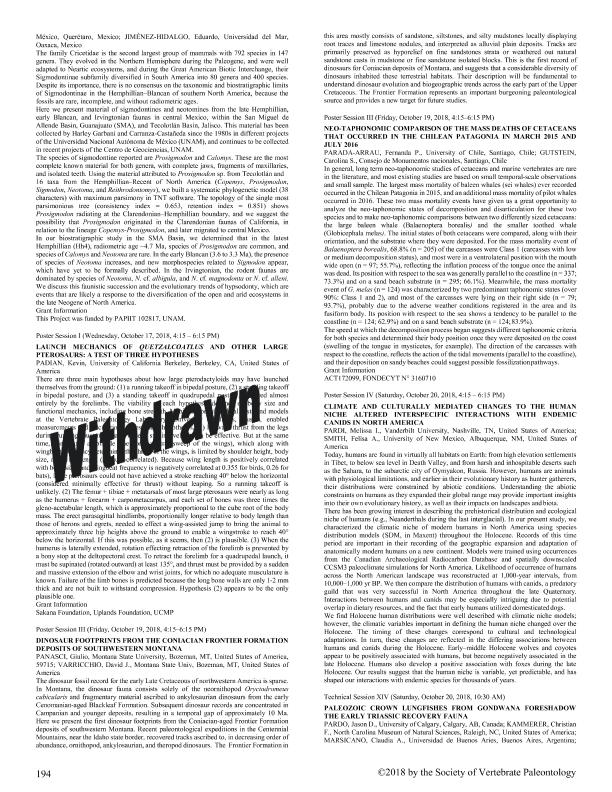Mostrar el registro sencillo del ítem
dc.contributor.author
Pardo, Jason
dc.contributor.author
Kammerer, Christian
dc.contributor.author
Marsicano, Claudia Alicia

dc.contributor.author
Angielczyk, Kenneth D.
dc.contributor.author
Fröbisch, Jörg
dc.contributor.author
Smith, Roger M. H.
dc.contributor.author
Cisneros, Juan C.
dc.date.available
2023-04-24T14:57:28Z
dc.date.issued
2018
dc.identifier.citation
Paleozoic Crown Lungfishes from Gondwana foreshadow the Early Triassic Recovery Fauna; Annual Meeting Society Vertebrate Paleontology; Estados Unidos; 2018; 1-2
dc.identifier.uri
http://hdl.handle.net/11336/195162
dc.description.abstract
Modern lungfishes are renowned for tolerance of extreme environmental variation, which is thought to contribute to their abundance during the recovery from the Permo-Triassic Mass Extinction (PTME). However, the Paleozoic origins of this clade and its biogeographic context remains unclear, with a 60 Ma ghost lineage at the base of the crown lungfish diversification spanning much of the Upper Carboniferous and the entirety of the Permian. This gap is particularly perplexing given the exceptional record of archaic lungfishes within this interval, particularly within paleoequatorial Euramerica, but also within eastern Europe. One possibility is that the assembly of the crown lungfish bauplan from known Carboniferous and Permian archaic lungfish groups occurred rapidly in the recovery from the PTME. However, an alternative explanation is that the crown lungfish bauplan evolved earlier in geographic regions outside the well-sampled Carboniferous and Permian basins of Euramerica, Russia, and South Africa. The sudden appearance of a diverse crown lungfish fauna in the earliest Triassic would then represent a biogeographic release in response to climate or diversity trends associated with the PTME. New lungfish faunas from outside these basins provide an opportunity to test these hypotheses. Here we report a diverse lungfish fauna from the Early Permian Pedra de Fogo Formation (Parnaíba Basin, northeastern Brazil) comprised of abundant lungfish toothplates and rarer associated or articulated skeletal remains. This fauna lacks archaic lungfish taxa (e.g. sagenodontids, ctenodontids, and conchopomatids) characteristic of contemporary localities in equatorial Euramerica. Instead, the Parnaíba fauna preserves a diverse assemblage of derived lungfishes, including a gnathorhizid and several crown lungfishes (ceratodontiforms). The gnathorhizid is represented by abundant toothplates and several partial skulls, and shows similarities to the North American gnathorhizid genera Persephonichthys and Gnathorhiza. The ceratodontiform, which is represented by toothplates as well as several partial skulls and skeletons, shows affinities with Triassic ptychoceratodontids and arganodontids, currently considered early members of the lepidosireniform stem group. Comparison with lungfish toothplate assemblages from the Paraná Basin of southern Brazil shows that the lungfish assemblage from the Parnaíba basin is also present in the Middle Permian of Brazil, likely representing a persistent biogeographic province in western Gondwana. We hypothesize that the lungfish crown group originated early in western Gondwana, but remained biogeographically restricted until the PTME eliminated incumbent competition in better-known biogeographical provinces.
dc.format
application/pdf
dc.language.iso
eng
dc.publisher
Allen Press Inc.

dc.rights
info:eu-repo/semantics/openAccess
dc.rights.uri
https://creativecommons.org/licenses/by-nc-sa/2.5/ar/
dc.subject
Lungfishes
dc.subject
Permian
dc.subject
Brazil
dc.subject
Palaeobiogeography
dc.subject.classification
Paleontología

dc.subject.classification
Ciencias de la Tierra y relacionadas con el Medio Ambiente

dc.subject.classification
CIENCIAS NATURALES Y EXACTAS

dc.title
Paleozoic Crown Lungfishes from Gondwana foreshadow the Early Triassic Recovery Fauna
dc.type
info:eu-repo/semantics/publishedVersion
dc.type
info:eu-repo/semantics/conferenceObject
dc.type
info:ar-repo/semantics/documento de conferencia
dc.date.updated
2023-02-27T16:00:25Z
dc.journal.pagination
1-2
dc.journal.pais
Estados Unidos

dc.journal.ciudad
Lawrence
dc.description.fil
Fil: Pardo, Jason. University of Calgary; Canadá
dc.description.fil
Fil: Kammerer, Christian. Museum Fur Naturkunde; Alemania
dc.description.fil
Fil: Marsicano, Claudia Alicia. Consejo Nacional de Investigaciones Científicas y Técnicas. Oficina de Coordinación Administrativa Ciudad Universitaria. Instituto de Estudios Andinos "Don Pablo Groeber". Universidad de Buenos Aires. Facultad de Ciencias Exactas y Naturales. Instituto de Estudios Andinos "Don Pablo Groeber"; Argentina
dc.description.fil
Fil: Angielczyk, Kenneth D.. Field Museum of National History; Estados Unidos
dc.description.fil
Fil: Fröbisch, Jörg. No especifíca;
dc.description.fil
Fil: Smith, Roger M. H.. University of Cape Town; Sudáfrica
dc.description.fil
Fil: Cisneros, Juan C.. Universidade Federal do Piaui; Brasil
dc.relation.alternativeid
info:eu-repo/semantics/altIdentifier/url/https://vertpaleo.org/wp-content/uploads/2021/03/SVP-2018-program-book-V4-FINAL-with-covers-9-24-18.pdf
dc.conicet.rol
Autor

dc.conicet.rol
Autor

dc.conicet.rol
Autor

dc.conicet.rol
Autor

dc.conicet.rol
Autor

dc.conicet.rol
Autor

dc.coverage
Internacional
dc.type.subtype
Reunión
dc.description.nombreEvento
Annual Meeting Society Vertebrate Paleontology
dc.date.evento
2018-10-17
dc.description.paisEvento
Estados Unidos

dc.type.publicacion
Journal
dc.description.institucionOrganizadora
Society of Vertebrate Paleontology
dc.source.revista
Journal Vertebrate Paleontology
dc.date.eventoHasta
2018-10-20
dc.type
Reunión
Archivos asociados
